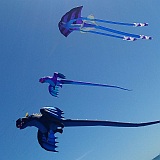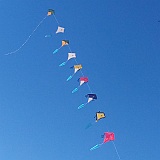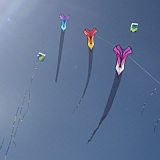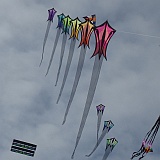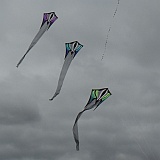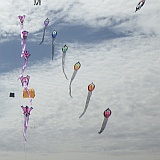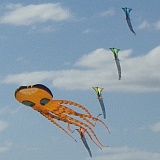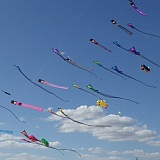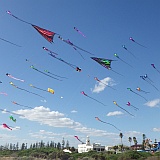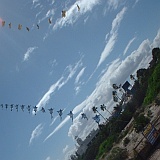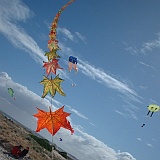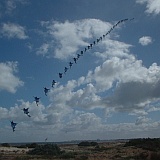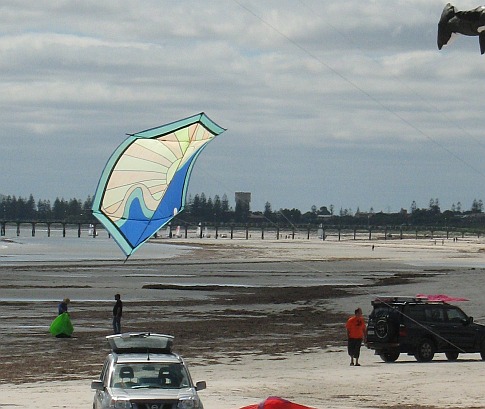- Home Page
- Kite Trains
Kite Train Spectacles
More Is Definitely More!
Who knows when the very first kite train floated up into the sky. But they have certainly been around for a long while. The idea is to attach several kites together through the same point on each.
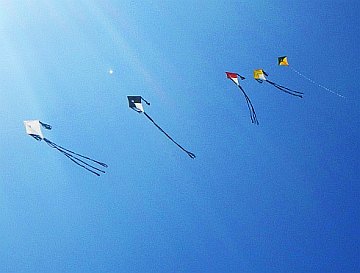 Carbon/Tyvek diamonds in a train
Carbon/Tyvek diamonds in a trainFor example, a simple diamond can have the flying line of another similar kite tied to where the spars cross. Then a third kite can be tied off to the second and so on.
In the case of our little MBK 1-Skewer Diamonds (covered in the Making Skewer Kites e-book), the tie-off point is slightly below the crossing point. There's a photo of two of these in flight, further down. That's thin 12-inch bamboo BBQ skewers, by the way.
Another approach with larger kites is to simply thread a flying line through a hole in each sail, near the towing-point position. Of course, this requires that each kite be secured to the flying line somehow so it doesn't slip all the way up the line when in flight!
Most trains feature kites at regular intervals. This has certainly been the case for every display we have seen at our local kite festival. But some flyers like to add a trick or two of their own to help stabilize the whole setup.
For some, this means a "pilot kite" flying on thin line right at the top. Others have tried spacing the top few kites a little further apart than the rest. Personally, I like all the random gyrating of more widely-spaced kites. The more the better as long as it all stays up there!
With very stable designs and smooth winds, the whole display can be almost static. In these cases, the swaying can be quite subtle, with long, slow ripples occurring along the line's length.
Peering back into the mists of time, the kites were large and the purpose rather more practical than just having some fun down at the beach. These early trains were all about carrying meteorological equipment (such as thermometers) up to various altitudes. This was more than a hundred years ago.
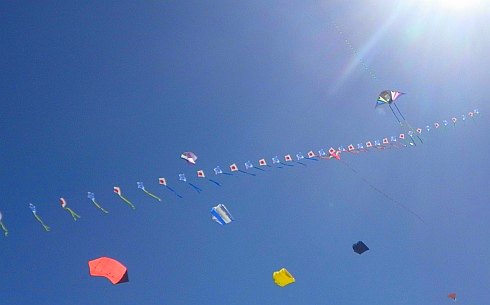 Australian and Japanese flags by kite master Mikio Toki
Australian and Japanese flags by kite master Mikio Toki
Kite-Train Categories
There are no official categories as such, but here are a few that have emerged for me, based on my own experience and research:
Scientific Workhorses. A century or two ago, large kites of several types were used to hoist scientific instruments into the air: hexagonals, Eddy diamonds, and various box-kite configurations. The multitude of kites on one line provided ample lifting power for this task. Also, taking simultaneous readings at various altitudes was a good fit for using a kite train. Temperature does go down as you go higher, they discovered!
Man-Lifting Systems. A few modern recreations of these old systems continue to be shown off at kite festivals around the world. A Dutch team is known for demonstrating a replica of Cody's man-lifting system of box kites. Would you be game to go up in the basket?
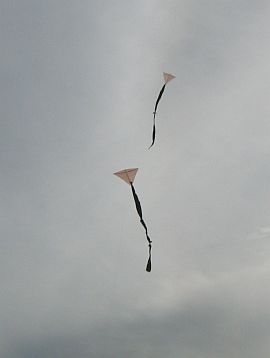 MBK 1-Skewer Diamonds
MBK 1-Skewer DiamondsHobbyist Projects. What was initially done for science looked like pretty good fun, in the eyes of keen kite-fliers! So it wasn't long before all sorts of single-line kites were being experimented with in this manner.
Several Eddy diamonds on one line would have been a simple and straightforward exercise. No doubt there were plenty of flat-tailed diamonds as well, all shifting around in loose formation.
This category persists to this day. Heck, I've put up a few tiny 1-Skewer Diamonds myself, all swooping around on a couple of hundred feet of 20-pound Dacron! There's a couple of them in the photo. I've also done a kite train with tiny barn-doors.
This brings me to a point: Modern trains tend to employ rather smaller kites than even the amateurs put up in yesteryear.
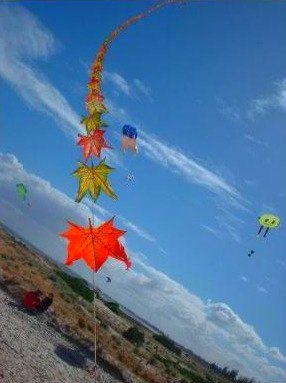 Taiwanese four-spar leaf kites
Taiwanese four-spar leaf kitesTraditional Asian. A good example is in Taiwan, where kite masters fly huge long stacks of bamboo-and-tissue kites. Having seen a couple of these firsthand at a festival, I can report that it was an amazing display of art, sheer kite performance, and impressive wind-range.
OK, I'll say that in English...
The trains looked like steep pillars rising into the air, and they flew in all kinds of wind. Even the flying line was of natural material. It was rather thick compared to the equivalent strength in braided Dacron, but it certainly did the job.
We took photos, of course, like the one here that features a realistic "autumn leaves" kite train.
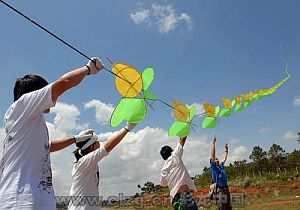 2,034 individual kites
2,034 individual kitesModern Novelty, Specialty, or Art Trains. OK, so that's three in one. What ties these subgroups together is the expertise, quality, and craftsmanship behind them.
The example in the photo is Chinese, but there are other examples from all around the world. Perhaps the Chinese do it best, though, when it comes to truly enormous projects! The photo is courtesy of china.org.cn.
The kite designs vary a lot, from a representation of the Great Wall of China to an exquisite train of glittering miniatures, each one just inches in height. The trains range from great, long formations of traditional-looking but hi-tech colorful diamonds to thoroughly modern and intriguing works of art in motion on a single line.
It seems that many expert kite-designers eventually get around to putting a train up, no matter what their specialty happens to be!
Modern Retail. The fact that a train of colorful kites looks intriguing and impressive has not been lost on modern kite-sellers! Hence there are a few products on the market that let you put together sizable trains of small-to-medium-size diamond kites.
These products tend to be for light-to-moderate winds and feature attractive, professionally done graphic designs. However, construction materials are at the cheap end of the scale in order to make the entire train affordable for casual flyers. They are certainly a lot of fun if the wind is right.
Wind-Speed Handy Reference
Light Air
1-5 kph
1-3 mph
1-3 knts
Beaufort 1
Light breeze
6–11 kph
4–7 mph
4–6 knts
Beaufort 2
Gentle ...
12–19 kph
8–12 mph
7–10 knts
Beaufort 3
Moderate ...
20–28 kph
13–18 mph
11–16 knts
Beaufort 4
Fresh ...
29–38 kph
19–24 mph
17–21 knts
Beaufort 5
Strong ...
39–49 kph
25–31 mph
22–27 knts
Beaufort 6
High Wind
50-61 kph
32-38 mph
28-33 knts
Beaufort 7
Gale
62-74 kph
39-46 mph
34-40 knts
Beaufort 8
Kite Trains: Art in Suspension
In recent years, it seems art trains have become more popular with designers. Here are some of the best that we have seen (or made!) at the Adelaide International Kite Festival (AIKF).
Click on a photo below to see it in greater detail.
My own Multi-Fly Diamond design used a unique approach for more flexibility. Special fittings allowed the line to pass around the kite. Apart from the local festival, I occasionally put up a train of these diamonds nearer home—as recorded in these kite train posts.
Here's our Animal Train in motion:
